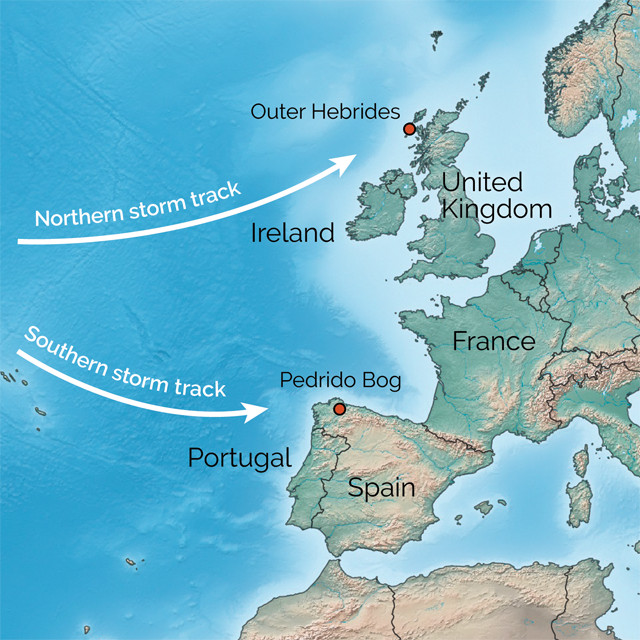
by Mary Caperton Morton Monday, May 15, 2017

Two sites studied by scientists — one in the Outer Hebrides of Scotland and one in northwestern Spain — capture records of moderate to large storms crossing the North Atlantic. Credit: K. Cantner, AGI.
As the Arctic warms, decreasing temperature differences between the Arctic and the lower latitudes may push North Atlantic storm systems south. The factors that influence storm tracks are complicated, however, and the accuracy of models predicting future storm tracks is uncertain. The results of a new study, in which researchers looked at changes in Atlantic storm tracks over the past 4,000 years, could improve the accuracy of predictive models and help Europe prepare for shifting storm patterns.
“We don’t know much about how storm tracks have varied in the past, and how storm tracks shift in the face of climate change is an understudied phenomenon,” says Mat Collins, a climate scientist at the University of Exeter in England who was not involved with the new study. “The more we can learn about the patterns of the past, the better we will understand how to model storm tracks in the future.”
To reconstruct the history of tracks from moderate and large storms traveling across the northern and southern reaches of the North Atlantic, Lisa Orme, a paleoceanographer also at the University of Exeter and at the Norwegian Polar Institute, and her colleagues collected sediment cores from bogs in Spain and Scotland. The two sites offered different perspectives on the effects of the North Atlantic Oscillation, a weather pattern that heavily influences atmospheric pressures over the Atlantic Ocean and controls storm tracks between the high-pressure zone near the Azores and the low-pressure zone near Iceland.
“We chose these two sites because they offered the strongest — and opposite — correlations with the North Atlantic Oscillation,” Orme says. Both sampling sites are located in what are known as ombrotrophic, or raised, bogs at least a kilometer inland from the nearest coastline. “Because they are raised above the [surrounding] landscape, the bogs only receive material from the atmosphere,” Orme says. “Beach sand can’t be washed in by water; it has to be brought by wind during a moderate to large storm.”
By identifying sandy deposits in the cores, the team tracked how often storms had swept over the sites. Between 4,000 and 2,000 years ago, more storms were seen at the Spanish site than at the Scottish site, the researchers reported in Geology. That implies that storms during that period tracked farther south on average. But starting about 2,000 years ago, storm tracks began to shift north, increasing in Scotland and decreasing in Spain. The northward shift hints at a steepening atmospheric pressure gradient across the North Atlantic, created by gradual polar cooling caused by decreased solar energy hitting the poles in the summer months coupled with warming in the midlatitudes caused by increased solar heating in the winter months.
Such long-term changes are driven by cyclical variations in Earth’s orbit around the sun, which affect the amount of solar energy that reaches the poles and midlatitudes. “The storm track changes we found were primarily caused by long-term orbital changes, which appear to have altered the sea-ice coverage and temperature gradients in the Atlantic Ocean,” Orme says.
The study offers climate modelers an opportunity to check the accuracy of their future projections, Collins says. “What we’d really like to do is take our models and wind them back 4,000 years, put in these changing orbital conditions and see how the storm tracks respond,” he says. Modeling storm tracks requires high-resolution data to map the sharp gradient between the warm and cold fronts that drive storms. “We’re just now getting to the point where we have [long-term] climate models with adequate resolution to resolve storm tracks,” Collins says.
“Recent evidence suggests that storm tracks may already be shifting south, and starting to affect southern Europe more,” Orme says. Warming in the Arctic is weakening the temperature gradient between the high and low latitudes, she says, potentially driving this southern shift. “Two thousand years ago, when there was a weaker temperature gradient, our study suggests that storminess was higher in southern Europe, so this study might provide an analogue for future changes,” she says.
So far, projections of future storm tracks tend to show only modest shifts, but those are still significant, Collins says. “A shift of a few degrees in latitude can have a huge impact,” Collins says. “In the U.K., a lot of our storms come from the north. If that path were to shift southward, we could see a significant impact on London, with more frequent and more intense storms.”
© 2008-2021. All rights reserved. Any copying, redistribution or retransmission of any of the contents of this service without the expressed written permission of the American Geosciences Institute is expressly prohibited. Click here for all copyright requests.